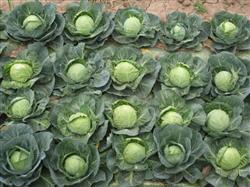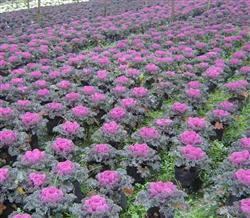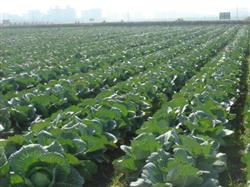How to grow pollution-free cabbage?

How to grow pollution-free cabbage? Please introduce in detail the planting methods for pollution-free cabbage cultivation can refer to the following methods: first, varieties select the varieties used for cabbage cultivation, depending on their cultivation purpose and time on the market. Early spring plastic film mulching cultivation in small arch shed mostly selects precocious varieties, such as Zhonggan 11, Beinong Zaosheng, 8398, Baochun, Yingchun, Brassica oleracea, cabbage, Beijing precocious. Mid-ripe varieties such as Jingfeng 1, Zhonggan 8, Qiulan, Qiufeng, ideal 1, Qingfeng 1, Xia Guang. Late-maturing varieties such as Huagan 2, Dongnong 609, Qiufeng, Wanfeng, Hanguang 1, Xinfeng cabbage, yellow cabbage. Mid-late maturing varieties are mostly used for summer and autumn cultivation. Second, in the cultivation season, cabbage in Shenyang is sowed and raised in early February, planted in early April and harvested in early June; summer cabbage is raised in early April and harvested in early August; autumn cabbage is generally sown in early June and harvested in early September. Third, sowing and raising seedlings. The preparation of nutritious soil is generally made of field soil, horse dung soil, peat and quick-acting fertilizer, and sandy loam soil is better. The preparation ratio is as follows: field soil 60% Mel 75%, horse dung peat soil 15% Mel 25%. Add 1.5 kg compound fertilizer per cubic meter of bed soil and mix it well for use. two。 Seed treatment to improve seed germination rate can be soaked in 50 ℃-55 ℃ warm water for 15 minutes, then natural cooling soaked seeds for about 3 hours, remove and dry under the condition of 22 ℃-24 ℃ to accelerate germination, pay attention to maintain humidity, generally sprout in 36 hours, wait for 80% of the seeds to sprout. 3. The sowing method flattens the seedling bed, pours through the bottom water, sprinkles a thin layer of sieve soil after the water seeps, and then sows. The sowing rate is about 4 grams per square meter, and the soil is evenly covered with 8 mm after sowing. In order to prevent the occurrence of blight, 50% carbendazim wettable powder can be used to sterilize the soil and mix 10 grams of carbendazim per square meter in covered soil. When the soil temperature of seedling raising in greenhouse is higher, dry seeds can be sowed after pouring sufficient bottom water. 4. Before seedling emergence, the daytime temperature was 20 ℃-25 ℃ and the night temperature was 13 ℃-15 ℃. After the seedlings were unearthed, the seedlings began to release properly, reduce the temperature and dampness and squat seedlings, 12 ℃-15 ℃ in the daytime and 5 ℃-8 ℃ at night, and then gradually increase the temperature, 15 ℃-20 ℃ in the daytime and 8 ℃-10 ℃ at night. When the seedlings grow to 2 leaves and 1 heart, the seedlings should be watered thoroughly and the higher temperature should be given appropriately. After slowing down the seedlings, it is necessary to timely ventilation, cooling management, to prevent overgrowth. When the stem diameter of the seedling is more than 0.5cm, the temperature should be kept above 15 ℃ as far as possible to avoid immature bolting through the vernalization stage. Spring cabbage is generally raised in Yangchi, and the seedling stage is 50 ~ 70 days. When planting, the ground temperature of 5 ℃ 10 cm is required to be 5 ℃-8 cm. The seedlings should be tempered at low temperature 7 days before planting to make them adapt to external conditions. Fourth, soil preparation, fertilization and cultivation of cabbage land should be combined with the application of organic fertilizer in advance of rotary tillage, soil preparation to make beds or ridges, and cover plastic film. The early-maturing varieties cultivated in early spring planted 5500 plants per mu, 5000 medium-maturing varieties, and 2000-3000 late-maturing varieties. Before transplanting, the use of eye punch, watering water planting. 5. Fertilizer and water management after planting slow seedlings under plastic film cultivation in early spring, watering should be properly controlled to increase the ground temperature. If there is a cold spell, ammonium sulfate can be applied in advance 15ml / mu 22.5 kg. Irrigation can enhance the cold resistance of the plant. Topdressing was carried out once in the rosette stage, and quick-acting nitrogen fertilizer was applied to 15,20kg per mu. Watering could be properly controlled at the end of the rosette stage, and weeds could be ploughed in time. Due to the selection of mid-late maturing varieties or bare land cultivation in summer and autumn, attention should be paid to weeding, increasing the times of topdressing and controlling irrigation, and pay attention to drainage after rain to prevent the rot of roots and leaf balls caused by stagnant water in the field. 6. Pest control 1. Soft rot. Pay attention to the selection of previous crops non-cruciferous crops, the application of fully mature farm manure. High beds are adopted for cultivation in summer to cultivate strong seedlings. The root was irrigated with 1000 times of water with dimethazone powder or 200 mg / kg of agricultural streptomycin. two。 Black rot. Select disease-resistant varieties, reasonable crop rotation, clean up the countryside, control insect pests, reduce wounds, scientific irrigation. Soak the seeds with 0.5% Dysenamine for 15 minutes before sowing, or soak the seeds with 50 ℃ warm water for 25 minutes. Before and at the beginning of the disease, mix well with 60% carbendazim or 35% pyrethromycin, add 50% thiram at 1:1, add 500x water solution, or spray agricultural streptomycin 200mg / kg or neophytomycin 200mg / kg once a day for 3 times, or seed dressing and root irrigation with agricultural resistance 75MU1 and Caifengning B. 3. Aphids. Remove weeds in time, remove residual plants and withered leaves in time after product harvest, and eliminate aphids. According to the positive tendency of aphids to yellow and the negative tendency to silver gray, yellow board was used to attract aphids or silver gray film was used to avoid aphids. The chemical control can be sprayed with 1000 times of 40% dimethoate EC or 50% aphid pine EC, or 2000 000 times of aldicarb wettable powder, which is effective against cabbage aphids. Generally, 6MUR is sprayed once every 7 days, and 2MUR is sprayed continuously for 3 times. 4. Cabbage worm. Clean up the residual branches and leaves in the field and plough the soil to avoid continuous cropping or intercropping with vegetables of the same family. Chemical control can be sprayed with 500 Mel 1000 times of Bacillus thuringiensis or 2000 Mel 3000 times with 20% fenvalerate EC, and green worm granulosis virus preparations can also be used for control. Harvest in time when the bulbs are basically covered and the outer leaves shine. Harvest the irregular pilling plots by stages. Click to get more cabbage planting techniques click to get more vegetable planting techniques
- Prev

How to cultivate kale in open field?
How to cultivate kale in open field? Please introduce in detail the planting methods and management methods for open field cultivation of kale can refer to the following methods: cultivation season: generally raising seedlings in protected fields from late March to early April, planting in the open field in the first and middle of May, and harvesting in the first and middle of June. Sowing and raising seedlings 1. Sow:.
- Next

How to apply fertilizer to grow pollution-free cabbage?
How to apply fertilizer to grow pollution-free cabbage? Please introduce the methods of planting pollution-free cabbage fertilization methods can refer to the following methods: re-application of base fertilizer, timely planting: protected cultivation of cabbage yield of about 30% than open field, and early listing, therefore, 20% more fertilizer than open field, more phosphorus and potassium fertilizer, nitrogen fertilizer.
Related
- Where is it suitable to grow horseradish in China? it is expected to see the middle altitude horseradish in Alishan.
- How to prevent tomato virus disease reasonably? (Control methods included)
- Many people like to plant towel gourd on the balcony. What are the main points of this method and management?
- What crops can chili peppers be mixed with?
- Fertilization techniques and matters needing attention in Tomato
- What are the grafting techniques for peach seedlings in spring?
- Harm and control methods of root swelling disease of Chinese cabbage
- What are the pests of sweet potatoes? How to prevent and cure it?
- Symptoms, causes and Control methods of navel Rot in Tomato
- The cause of "Cucumber rotten bibcock" in Farmers' planting Cucumber and its Control Plan

